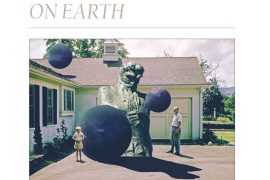Our Interviews Editor Esteban Rodríguez speaks with Adam O. Davis about his debut collection Index of Haunted Houses (Sarabande Books, 2020), the importance of connecting history with our present, and how place can shape our understanding of who we are and who we want to be.
ER: You’ve mentioned in previous interviews that Index of Haunted Houses began in the wake of the Great Recession (2007-2009) and the subprime mortgage crisis. How did the first poems in the collection mirror this new economic reality?
AD: The first poem I wrote for what became Index of Haunted Houses was “Fever Land, 1499,” which featured Christopher Columbus—one of the worst landlords in world history—on his deathbed suffering visions of the future he made possible: tract homes clad in termite tents advancing across this country’s deserts. Having been taught as a young person that Christopher Columbus’ story was the story of America, a story that my own self-education would eventually prove to be not of noble discovery but violent exploitation, the poem led me to think about how the concerns of the Great Recession were the same as the Age of Discovery: ownership. This is a country that has made a serious and sustained industry out of possession, a country that has often deliberately confused the body with property and vice versa, so when I kept hearing the word “repossession” over and over again on the news, it spoke to the spectral politics of homeownership in America: the way we’re encouraged to look at homes as the sum of our being and what it means when such a sum can be taken away and by whom. The poems that followed echoed this concern both in content and form—the physical arrangement of lines on the page became more fragmented and tenuous, reflecting the anxiety and uncertainty of the times, as if each poem was a house with only a window or two lit.
ER: There are many poems that reference a certain year—1499 (as you mentioned above), 1947, 1780, 1890. However, there is a timelessness to the setting of the poems that doesn’t feel like you’re necessarily looking into a window of the past. The image of an abandoned house in 1978 could be a scene you find just down the road today. How did this cohesion come about?
AD: One of the things that I sought to explore in the book was how our haunted places speak to the evolution of things, particularly from a historical standpoint. Everything is the sum of everything—especially time—and I wanted to play with that notion in the dated poems by relaxing the strictures of history so that anachronisms and repetition could enter the pieces, allowing history to enter into conversation with itself. Anne Carson does this to tremendous effect with her contemporized Greek mythology in Autobiography of Red, as does David Lynch in his films whose dates can range from 1920-2018 in a span of minutes. In both of those artists’ works, there’s a dreamy logic to the proceedings that makes the times they describe—though impossible—more vivid for their historical vagueness. I wanted that same kind of rich ahistorical fogginess in my book, whether it was in poems like “Roswell, 1947,” that uses the fear of aliens to speak to this country’s longstanding obsession with invasion, or “Extinction Days, 1873,” that describes the environmental wages of progress. In doing so, I was hoping to engineer poems that would operate like ghosts, whose recursive nature demands they echo the past in every present they haunt.
ER: The photographs throughout the book, which I understand you took yourself, carry with them an eeriness that so adequately complements the poems. There is an abandoned motel, an empty street, a dilapidated gas station, all of which not only serve as interludes, but as moments of reflection. How did the photos make their way into the collection?
AD: I’ve always been a visual thinker and whenever I’ve needed a break from the page photography has been both a personally regenerative and creatively generative practice for me. As you mention, my photographic interests are in line with my poetic ones: texture, shading, form, exposure, abandonment…the list goes on. But despite these shared interests I never thought to integrate the two until Ilya Kaminsky suggested it to me back in 2017. My initial response was, “You can do that?” to which he said, “Of course. Look at how your poems and photographs interact.” At first I was wary of the idea as I didn’t want to distract from the poems or for the photographs to be considered some kind of crutch for the book to lean on, but once I included them the poems seemed to burn brighter–as did the photographs. The lesson in all this was that I was—like many a first-time writer—waiting for permission to do something I should’ve done in the first place, especially since I’ve always loved books that work in several genres or mediums at once.
ER: In many poems, spacing is used not only for the purpose of providing pause, but for providing the ghosts of the text room to occupy the page (“Ghost of Macondo” and “A House Unfit Even for Ghosts,” for example). How do you view the page when you set out to write a poem?
AD: The consideration of the page is an essential but late-breaking part of my process. Invariably, my poems begin as chunks of prose that go abandoned until I can return to them with fresh eyes, judicious as a magpie as I comb through them for their brightest, shiniest moments. Then comes the shaping which may involve a delicate pruning or a full-scale demolition (in the case of the poems in the book, it was often the latter). Once I feel like the poem has largely arrived at what it wants to be, I place it on the page and begin my experiments. Chiefly, I’m interested in seeing how the ink responds to the whiteness that threatens to drown it (Glyn Maxwell says masterful things about this necessary danger in his book, On Poetry), so at this stage it’s all about testing the proverbial waters with different forms. I’ll typically test out four or five different versions of the poem at once, seeing how they hold together and whether the form is indeed serving the function (and vice versa). In the end, it’s a question of imagining the poem as a vessel that fills the page, so which vessel works best? (This was a very important consideration for Index of Haunted Houses as many poems’ vessels worked fine when printed in journals but needed something entirely different for the book.) In all this, I tried to keep an open mind. Harkening back to my bartending past, decorum would dictate that an ounce of B&B should be served in a snifter, but how much more interesting would that beverage be if served in an hourglass? The same logic applies for poetry.
ER: Your book took more than a decade to write, and often there is a pressure on poets to put out one book after the next. What’s next for you?
AD: In many ways I’ve been working toward a second book for almost as long as I was working on the first one. This is because I realized that I needed a second project to keep me sane during that long stretch when rejection after rejection rolled in along with the doubts they cast over my hopes for the book I’d been submitting. With a second project, there were lower stakes, and the manuscript I unknowingly began served as an aspirin for the headaches and heartaches that are an intractable part of the contest system. The new book kept me hopeful and, more importantly, kept me writing when I tired of working on the Index. As a result, I’m nearly done with a second collection of poems that I feel has broken some important ground for me as a poet. And, as if that weren’t enough, I started working on a novel too (I recently finished what I’d like to believe is a final draft). I think a big part of our job as writers is to design tricks to get us back to the page. As ever, it’s the work that redeems us.
ER: Obviously, the promotion of a book is something all authors do, and you took quite a unique approach, setting up a hotline where potential readers can call in and learn more about the collection. Callers can also leave a message. What has your experience with the hotline been thus far, and how do you feel it has complemented the book?
AD: Given the increasing dominance that visual culture holds over us—and all the more so during this pandemic—I wanted to offer listeners a more intimate experience with the book. One of the things I love about telephone conversations is the importance they place on the use of our voices because they allow us only our voices. Everything else is stripped away and you’re able to exist solely in the realm of sound—the body disappears and your thoughts and ideas become as physical as any face. (I have a theory that the popularity of podcasts is due to the loss of telephone conversations in response to texting—we miss the phone but no longer have time for it so it makes sense that we’d gravitate to the cozy intimacy of Roman Mars et al.) Just as with the book, I wanted the hotline to operate as a series of rooms within the same house. With that in mind, I had a lot of fun designing the phone tree (basically the “map” for the hotline)—some numbers take you to a dead end, some lock you in a repeating cycle, and some keep opening up door after door into new rooms. I wanted the hotline to be both complementary and independent of the book. In many ways, it’s the book’s ghost, both of it and not at once.
Since launching the hotline back in April, I’ve had a couple hundred people call in from all over the world. Some have left messages (often street sounds or birdsong or one woman’s voice saying forever, forever, forever before disconnecting) while others prefer simply to listen. My hope now is the same as it was when I came up with the hotline: To offer those who wouldn’t be able to attend a reading a chance to hear the poems. Little did I know how much more necessary that idea would become with the pandemic.
ER: What advice would you give your younger self?
AD: The question is whether my younger self would’ve accepted the advice I’m now eager to impart, but if I could advise myself with some success, I suppose I’d tell myself to trust myself (something I’m still trying to tell myself, though more successfully these days). I spent so many years during the submissions process anxious, heartened, jealous, hopeful, and despondent, always wondering when my chance might come and then worrying if I’d missed it. What I didn’t know then was that so long as you’re working, you have nothing but opportunity before you. It’s only if you stop, if you quit or give up, that that opportunity disappears. At the end of the day, only the poems matter. You owe it to yourself and the words to keep going. For me, when I find time to write, my faith is rewarded, my sense of potential redeemed. Anything could happen. Write one word, then another, then another, and look: you’re already in a new world. Who knows where you might arrive at next? Who knows what wonders you’ll find there?





